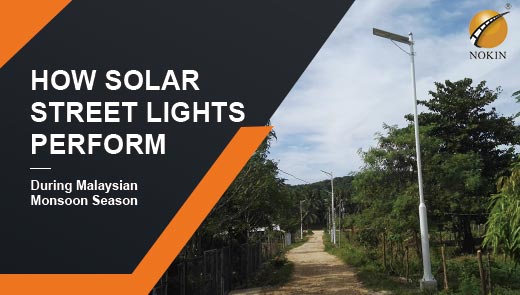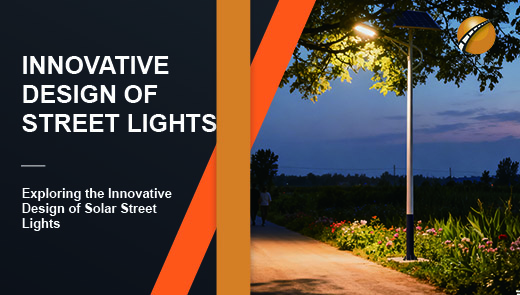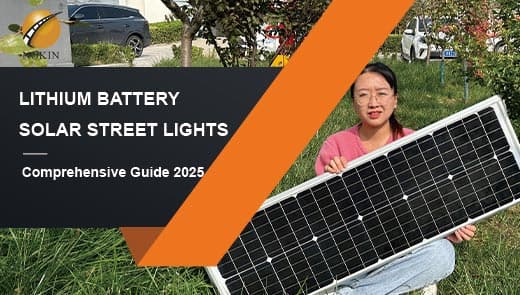Optimal Locations for Solar Street Light Installation
As the core equipment of green energy lighting, the working principle of solar street light contains a precise logic of energy conversion. The solar panel is like a “light energy harvester”, through the photovoltaic effect of sunlight into direct current, the efficiency of this process directly determines the energy base of the system. The converted electricity is regulated by the solar charge controller, which on one hand charges the lithium iron phosphate battery pack and on the other hand drives the solar LED street lamps for night lighting. Controller as the system's “intelligent housekeeper”, not only to prevent the battery overcharging and over-discharging, but also according to environmental needs to realize the timed dimming, motion sensor (motion sensor) response and other functions.
However, the performance of this set of precision systems to play, highly dependent on the scientific choice of installation location. Imagine a solar panel covered by the shadows of high-rise buildings for a long time, even with the most efficient components, it is difficult to achieve the goal of average daily charging; and in the permafrost zone without thermal insulation treatment of the battery, due to the low temperature of the capacity of the rapid attenuation. In this paper, Nokin will analyze the optimal location strategy for solar street light installation from the three dimensions of influencing factors, siting principles, and scene adaptation to help practitioners and decision makers build a systematic siting methodology.
What are the Factors that Affect the Work of Solar Street Lights?
Lighting Conditions
Quantitative impact of sunshine duration
Sunshine duration directly determines the average daily power generation of solar panels. Taking a 100W monocrystalline silicon solar panel as an example, in an area with 5 hours of average daily sunshine, the single-day power generation is about 0.45kWh; while in an area with 8 hours of sunshine, the power generation can be increased to 0.72kWh, a difference of 60%. This means that in cloudy and rainy areas, the inherent shortcomings need to be compensated for by increasing the panel area or battery capacity. For example, in China's Sichuan Basin, where the average annual sunshine is only 1,000-1,400 hours, the solar street light system design needs to increase the battery capacity by 30%-50% to cope with the energy gap of continuous cloudy and rainy weather.
Dynamic challenges of light stability
Sudden changes in weather can have a far greater impact on a system than expected. Three consecutive days of rain can reduce battery capacity to less than 50%, and if cold temperatures are experienced at this time, the range may plummet to 30% of the design value. Some coastal cities may have more than 7 consecutive days of rain brought about by a typhoon, resulting in a large area of solar street light systems that have not been expanded to turn off the lights, exposing the importance of light stability assessment. In practice, NASA's SSE (Solar and Space Environment) database can be used to obtain multi-year meteorological data for the target area, and calculate the “continuous rain safety threshold” as a key parameter for battery capacity design.
Difference in efficiency between direct and diffused light
The conversion efficiency of solar panels under direct light can be as high as 18%-22%, while it may drop below 10% under diffused light conditions. This explains the significant difference between the performance of the same solar street light in an open parking lot (direct light dominant) and a boulevard (diffuse light dominant). In scenarios where scattered light cannot be avoided, double-glazed modules or nano-coating technology can be used to improve light absorption in low-light environments.
Temperature Effect
Temperature characteristic curve of lithium iron phosphate battery
The ideal working temperature of Li-FePO4 battery is 25℃, when the ambient temperature drops to 10℃, the capacity retention rate is about 85%; it plummets to 60% at 0℃; and at -10℃, it can only maintain 40% of the effective capacity. A northeastern industrial park was not equipped with battery heating system, winter night lamps and lanterns brightness dropped 70% compared to summer, seriously affecting the safety of lighting. Solutions include pre-buried PTC heating pads (power 5-10W) or phase change material insulation to maintain the battery compartment temperature in the 5-15℃ range.
Heat dissipation management in high temperature environment
In tropical areas, the temperature of the battery compartment may exceed 50℃ in summer, resulting in a shortening of the battery cycle life by more than 30%. At this time, it is necessary to use aluminum alloy hollow shell (heat dissipation coefficient ≥ 200W/m-K) with heat pipe cooling technology to control the temperature within 40 ℃. For example, the solar street light project in an oil town in the Middle East, through the optimization of heat dissipation design, the battery life has been extended from the expected 5 years to 8 years, which significantly reduces the operation and maintenance costs.
How to Choose the Right Location for Solar Street Lights?
Roads and Traffic
The golden rule of spacing design
The road width is linearly and positively correlated with the spacing of the solar powered street lights: two-way two-lane road (width of 7 meters) is recommended to use 8-10 meters spacing with 30-50W LED lamps; urban trunk roads (width ≥ 15 meters) need to use 6-8 meters spacing, and the power of lamps and lanterns is enhanced to 80-100W to meet the urban road lighting design standards of the Illumination requirements.
Encryption strategy for special road sections
In accident-prone areas such as curves, ramps, intersections, etc., the solar street light spacing needs to be shortened to 50%-70% of the conventional value, and solar street lights with anti-glare design need to be configured. For example, in the continuous curved section of the mountainous highway, the 6-meter spacing + batwing light distribution curve luminaire can effectively reduce the glare of oncoming vehicles and enhance the safety of nighttime driving.
Peripheral Facilities
Safety distance of overhead lines
According to “Regulations on the Protection of Electric Power Facilities”, the horizontal distance between solar street lights and high-voltage lines of 10kV and below shall not be less than 3 meters, and the distance to lines of 35kV or above shall be maintained at least 5 meters. It was once reported that an industrial park's installation of lamps under 10kV lines in violation of the law led to an arc discharge accident during a thunderstorm, resulting in equipment damage and localized power outages.
Survey process of underground pipeline network
Before construction, underground pipeline mapping is required through ground-penetrating radar (GPR) to ensure that the foundation of the solar led street light maintains a horizontal distance of more than 1.5 meters from the gas pipeline, communication fiber optic cables and so on. In the old city renovation project, there was a failure to detect the old underground water pipes, which led to the rupture of water pipes during the foundation construction and triggered a regional water outage, highlighting the need for pre-surveys.
Microtopography and Soil
Design principles of anti-ponding
The elevation of the installation location needs to be higher than the surrounding ground by 30-50cm, and if it cannot be satisfied, then elevated base (height ≥80cm) and drainage blind ditch should be constructed. In some wetland park projects in coastal cities, because the solar powered street lights are installed in depressions, the depth of water in the typhoon season reaches 1.2 meters, resulting in 30% of the lamps and lanterns being scrapped due to internal water ingress, and the cost of later renovation increases by 40%.
Engineering calculation of soil bearing capacity
For soft ground (bearing capacity ≤80kPa), pile foundation or expanded foundation design is required. Taking powdery clay soil with a bearing capacity of 60kPa as an example, the conventional 3-meter pole foundation needs to increase the burial depth from 1.2 meters to 1.8 meters and be equipped with reinforced concrete bearing platforms to resist the overturning moment of extreme weather such as typhoons.
Light Optimization for Solar Street Lights
Time Window for Shading Analysis
Focuses on evaluating shading from 9 a.m. to 3 p.m., a time period when effective light accounts for 60-70% of the total daily average. SketchUp's Sunlight Tool plug-in can be used to simulate shadow changes throughout the year. In a school playground installation project, the simulation found that the north side of the school building would block part of the area after 2:00 p.m. in winter, and eventually adjusted the position of the lamps and lanterns to the south side of the playground, to ensure that there is sufficient light throughout the time.
Quantitative assessment of obstacles
Establishment of the “shading index” formula: shading index = obstacle height / (installation point and the horizontal distance of the obstacle). When the index is >0.5, measures such as removing the obstacle, elevating the pole or adjusting the installation position should be taken.
Latitude Adaptation
Tilt angle calculation model
Based on Hottel's formula, the tilt angle α=local latitude±adjustment coefficient (taking “-” in summer and “+” in winter). Taking Beijing area (latitude 39.9°) as an example, the optimal tilt angle is 30° in summer and 45° in winter, and the average of 37° in the whole year can balance the efficiency of each season. Some practical is system tools can be used in actual projects to dynamically adjust the tilt angle to increase the annual power generation by 20-30%.
Tolerance of orientation deviation
In the northern hemisphere, the power generation loss is about 5%-8% when the panel orientation deviates ±15° from due south, and up to 15%-20% when it deviates ±30°. In a mountainous highway, the panels are forced to face southeast (22° deviation) due to topographical constraints, and the efficiency loss caused by the deviation in orientation is compensated by increasing the panel area by 15%.
Which Sites are Suitable for Installing Solar Street Lights?
Rural and Suburban
Core demand: Low maintenance cost, high reliability
Configuration points: Adopt integrated solar street light (installation complexity reduced by 50%), battery capacity designed according to 5 consecutive days of cloudy and rainy, and panel power matched with 4-5 hours of average daily sunshine conditions.
City plaza and parking lot
Core requirements: Uniform illumination, intelligent control
Technical solutions: Multi-lamp grouping + Zigbee wireless control, lamp spacing of 8-10 meters, configured with 100W LEDs + 150W panels, and automatic dimming of dusk-to-dawn (dusk-to-dawn) through photosensitive sensors. In a commercial plaza renovation project, microwave radar sensors were introduced to increase the brightness from 30% to 100% when people's activities were detected, with an energy saving rate of 65%.
High-end Villa Area
Design Principle: Concealed Installation + Customized Appearance
Innovative Practice: Adopting buried solar lights (height ≤30cm above ground) with stone-like shells, and integrating panels on roofs or landscape corridors to achieve the effect of “no light, no light”. In a villa project in a developed area, 200 buried lights and garden paths combined, night illumination control in 15-20lx, creating a warm atmosphere at the same time, light pollution than the traditional street lamps to reduce 80%.
Remote Island
Key Technology: Typhoon Resistant Structure + Seawater Corrosion Protection
Project Case: In a solar powered street light project on an island, the light pole adopts aviation-grade aluminum alloy (tensile strength ≥300MPa), with fluorocarbon spray treatment on the surface (salt spray test ≥5000 hours), and the panel is configured with anti-bird spikes and automatic cleaning device. The system is designed to withstand grade 12 typhoon, and the battery compartment is equipped with built-in electric heating module to ensure normal operation in -5℃ environment.
Industrial Park
Special Requirements: Explosion-proof and anti-corrosion + Intelligent Energy Management
Solution: Explosion-proof LED lamps are used in the chemical industry area (in accordance with Ex d IIB T4 Gb standard), and the panel bracket is made of 316L stainless steel (with corrosion resistance coefficient ≥ 0.8). Through the PLC control system, the brightness is dynamically adjusted according to the production shifts, such as dropping to 30% power during unoccupied hours at night, and the annual energy saving rate can reach more than 40%.
Conclusion
The site selection for solar LED street light installation is by no means a technical decision in a single dimension, but a systematic project involving climatology, engineering and economics. From the preliminary meteorological data modeling and micro-topographic survey, to the mid-term component selection and structural design, to the later operation and maintenance strategy development, each link needs to “maximize energy efficiency” as the core objective.
With the continuous breakthroughs in technology and the in-depth intervention of AI algorithms in light prediction, the siting methodology will be further intelligent and precise, and the paradigm shift from “empirical siting” to “data-driven siting” will be realized in the future, so that every solar street light will be able to bloom green light in the best location.




